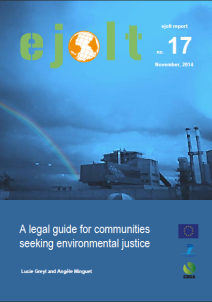
How can Environmental Justice Organisations (EJOs), local communities or citizens make justice happen? What are the rules, tools and opportunities to fight back against environmental injustice? The report “A legal guide for communities seeking environmental justice” looks at a wide range of legal avenues that can work. It’s made for those defending a worldwide frontline, a struggle against attacks to Mother Earth, the public goods and communities. It comes with an annex that serves as online library: an overview of all relevant legal road, fully hyperlinked. As this global struggle goes on and impunity becomes standard practice, the need for procedural justice is growing. Tapping into the competences and knowledge brought together in EJOLT’s program on Law and Institutions, this manual is written on which legal tools EJOs from all over the world use and how to expand them
Tendencies in processual justice
Famous environmental lawsuits are explained in the manual to discuss tendencies and tips to obtain justice. In the last 20 years new practices like transnational trials and new dynamics among stakeholders have taken place. While some processual justice cases were successful, remediation, precautionary measure and non-recurrence still lack. Among the major trends, we can notice the fundamental role of collective or class action, where bottom-up processes have been implemented, like in the case of Shell in the Netherlands. Winning judgements are often based on the non application of norms, of risk and security measures, or on the respect of duty.
A reason for hope is that the role of communities and EJOs role in such trials is increasing. They have brought innovative approaches to legal strategy, supported processual justice with fundamental information and proof collection and implemented communities’ participative processes for the development of claims and requests. Another common asset is the visibility such cases have given to environmental injustice situations, which is fundamental to exercise pressure for example on a defendant company’s image, as media attention brought on those trials reinforces the circulation information and awareness.
Key advantages of the manual
The manual provides information on who can fill a lawsuit/action before a Court or institutional bodies, how it needs to be done and links to contacts and models of demands. It is composed of 3 main parts. In the first part you will find information regarding civil law tools at international, regional and transnational levels. The second part is about international, regional and national criminal tools and bodies. The last part provides information on the defence of environment defenders and other instruments and strategic views based on good practices.
- The manual also provides information on key concepts, guidance and practical examples on lessons learned from past legal experiences.
- The manual translates information that is often considered as ‘too difficult’ into a language that is easy to understand. It also wants to provide basic information for EJOs on how to defend criminalised or threatened environmental justice defenders
- It aspires to be an easily accessible “online library”. The annex provides hyperlinks to further documentations and technical information and contacts of legal institutions and EJOs who work in this field.
While it is not exhaustive, the manual does cover ample information, including court cases, cross-countries legal instruments, etc.
The report can be downloaded here.
The annex/online library is here.
The executive summary is here.


